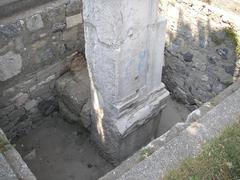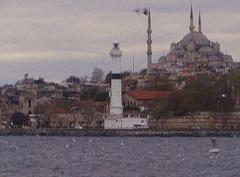Comprehensive Guide to Visiting Hatice Turhan Sultan Türbesi, Istanbul, Türkiye
Date: 01/08/2024
Introduction
Visiting the Hatice Turhan Sultan Türbesi in Istanbul, Türkiye, offers an immersive journey through Ottoman history and architecture. This mausoleum, part of the Yeni Mosque complex in the bustling Eminönü district, serves as the final resting place for Hatice Turhan Sultan and several Ottoman sultans. Hatice Turhan Sultan, a significant figure during the Sultanate of Women, was known for her political acumen, philanthropy, and architectural patronage. Built in 1663 by the architect Mustafa Ağa, her tomb stands as a testament to her enduring legacy and the architectural brilliance of the Ottoman Empire (Wikipedia). This guide aims to provide comprehensive information on the historical background, architectural features, visiting hours, ticket prices, travel tips, and nearby attractions, ensuring a memorable visit to this historical gem.
Table of Contents
- [Introduction](#introductionintroduction)
- [Historical Background](#historical-backgroundhistorical-background)
- [Origins and Early Life of Hatice Turhan Sultan](#origins-and-early-life-of-hatice-turhan-sultanorigins-and-early-life-of-hatice-turhan-sultan)
- [Regency and Political Turmoil](#regency-and-political-turmoilregency-and-political-turmoil)
- [Philanthropy and Architectural Contributions](#philanthropy-and-architectural-contributionsphilanthropy-and-architectural-contributions)
- [The Construction of Hatice Turhan Sultan Türbesi](#the-construction-of-hatice-turhan-sultan-türbesithe-construction-of-hatice-turhan-sultan-türbesi)
- [Architectural Features](#architectural-featuresarchitectural-features)
- [Cultural and Historical Significance](#cultural-and-historical-significancecultural-and-historical-significance)
- [Visitor Experience](#visitor-experiencevisitor-experience)
- [Practical Information for Visitors](#practical-information-for-visitorspractical-information-for-visitors)
- [Nearby Attractions](#nearby-attractionsnearby-attractions)
- [FAQ Section](#faq-sectionfaq-section)
- [Conclusion](#conclusionconclusion)
- [Sources](#sourcessources)
Historical Background
Origins and Early Life of Hatice Turhan Sultan
Hatice Turhan Sultan, born around 1627 in present-day Ukraine or possibly Russia, was kidnapped at the age of twelve and taken to Constantinople. She was given to the household of Sultan Ibrahim I of the Ottoman Empire. Turhan quickly rose to prominence as a favorite concubine of Sultan Ibrahim I, bearing him a son named Mehmed. When Ibrahim was deposed due to his mental instability and subsequently killed, Mehmed ascended to the throne as Mehmed IV at the tender age of seven (source).
Regency and Political Turmoil
Initially, Turhan was passed over for the regency due to her lack of political experience and support within the court. Instead, Kösem Sultan, Turhan’s mother-in-law and Mehmed IV’s grandmother, assumed the role of regent. This arrangement led to significant tension between Turhan and Kösem, culminating in a violent power struggle that lasted for three years. Turhan eventually orchestrated Kösem’s assassination, thereby ending the internal conflict and securing her position as regent (source).
Philanthropy and Architectural Contributions
Once in power, Turhan Hatice Sultan focused on philanthropic and ceremonial roles rather than pursuing further political ambitions. She was instrumental in the construction and restoration of various mosques and fortresses throughout the Ottoman Empire. One of her most notable contributions was the construction of the Yeni Mosque in Istanbul, where she was eventually buried. Turhan also amassed vast libraries, contributing significantly to the cultural and intellectual landscape of the empire (source).
The Construction of Hatice Turhan Sultan Türbesi
The Hatice Turhan Sultan Türbesi, or the Tomb of Hatice Turhan Sultan, was built in 1663 by the architect Mustafa Ağa. Located in Istanbul’s Suriçi Eminönü district, within the Yeni Mosque complex, the tomb is a significant architectural and historical site. The tomb houses the remains of five Ottoman sultans: Mehmed IV, Mustafa II, Ahmed III, Mahmud I, and Osman III (source).
Architectural Features
The tomb is an exquisite example of Ottoman architecture, featuring intricate tile work, calligraphy, and ornate decorations. The interior is adorned with Iznik tiles, known for their vibrant colors and intricate designs. The tomb’s dome is a masterpiece of Ottoman engineering, showcasing the architectural prowess of the period. Visitors can also observe the beautifully crafted wooden doors and windows, which are adorned with mother-of-pearl inlays (source).
Cultural and Historical Significance
The Hatice Turhan Sultan Türbesi is not just a burial site but a symbol of Turhan’s enduring legacy. Her contributions to the Ottoman Empire, particularly in the realms of architecture and philanthropy, are immortalized in this tomb. The site serves as a testament to her influence and the pivotal role she played during a turbulent period in Ottoman history. The tomb is also a significant cultural landmark, attracting visitors and scholars interested in Ottoman history and architecture (source).
Visitor Experience
Visitors to the Hatice Turhan Sultan Türbesi can expect a serene and contemplative experience. The tomb is located within the bustling Eminönü district, offering a stark contrast between the tranquility of the tomb and the vibrant life of the surrounding area. The Yeni Mosque complex, where the tomb is situated, is a popular destination for both tourists and locals, providing a rich cultural and historical context for the visit (source).
Practical Information for Visitors
- Visiting Hours: The tomb is open to visitors throughout the year. It is advisable to check for any special closures or events that might affect access.
- Ticket Prices: Entry to the tomb is free, but donations for its maintenance are appreciated.
- Accessibility: The site is accessible by public transportation, with several tram and bus lines serving the Eminönü district. As with many historical sites in Istanbul, modest dress is recommended out of respect for the cultural and religious significance of the location. Photography is generally allowed, but visitors should be mindful of any restrictions and always respect the sanctity of the site.
Nearby Attractions
The tomb’s location in the heart of Istanbul makes it an ideal starting point for exploring other historical and cultural landmarks. Nearby attractions include the Spice Bazaar, known for its vibrant array of spices, sweets, and other goods; the Hagia Sophia, a masterpiece of Byzantine architecture; and the Golden Horn, a natural harbor that has played a crucial role in the city’s history. Visitors can also explore the bustling streets of Eminönü, which offer a variety of shops, cafes, and restaurants (source).
FAQ Section
- What are the visiting hours for Hatice Turhan Sultan Türbesi? The tomb is open throughout the year. Check for any special closures or events that might affect access.
- How much do tickets cost for Hatice Turhan Sultan Türbesi? Entry is free, but donations are appreciated.
- Is the site accessible by public transportation? Yes, the Eminönü district is well-served by tram and bus lines.
- Are there guided tours available? While the tomb itself may not offer guided tours, there are many tour operators in Istanbul that include the site in their itineraries.
Conclusion
The Hatice Turhan Sultan Türbesi offers a unique glimpse into the life and legacy of one of the most influential women in Ottoman history. From its architectural splendor to its historical significance, the tomb is a must-visit for anyone interested in the rich cultural tapestry of Istanbul. Whether you are a history enthusiast, an architecture aficionado, or simply a curious traveler, the Hatice Turhan Sultan Türbesi promises a memorable and enriching experience.
Call to Action
Plan your visit to Hatice Turhan Sultan Türbesi today and immerse yourself in the rich history and culture of Istanbul. Don’t forget to download our mobile app Audiala for more travel tips and updates on historical sites. Follow us on social media for the latest posts and travel inspiration.
References
- The Exasperated Historian, Turhan Hatice Sultan, 2024 (source)
- Komoot, Highlight: Hatice Turhan Sultan Türbesi, 2024 (source)
- Mapcarta, Hatice Turhan Sultan Tomb, 2024 (source)
- Wikipedia, Tomb of Turhan Sultan, 2024 (source)
- Lonely Planet, Hatice Turhan Valide Sultan Tomb, 2024 (source)
- History of Royal Women, Turhan Hatice Sultan, 2024 (source)
- Wander Lush, Visit Istanbul Travel Tips, 2024 (source)



